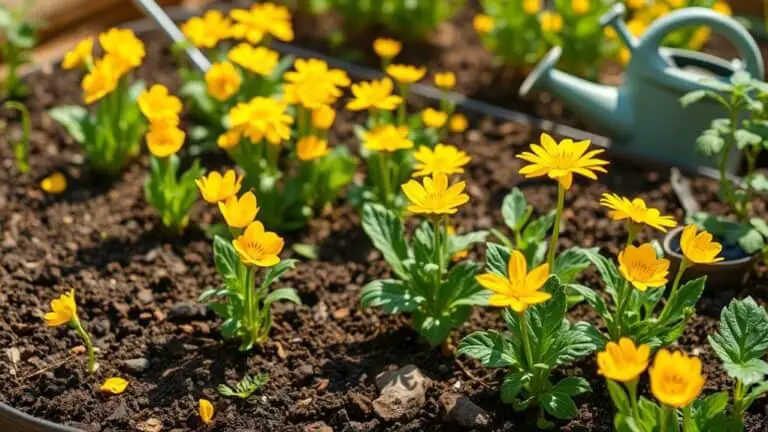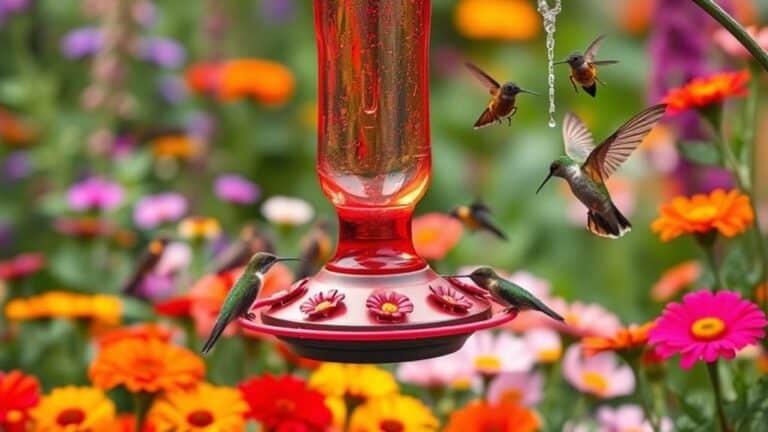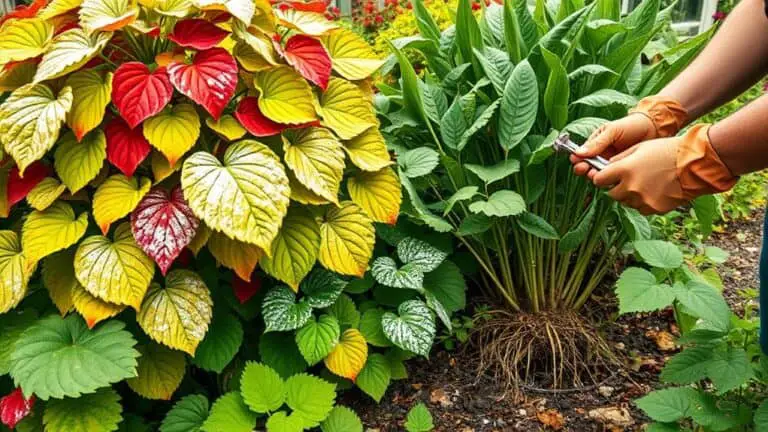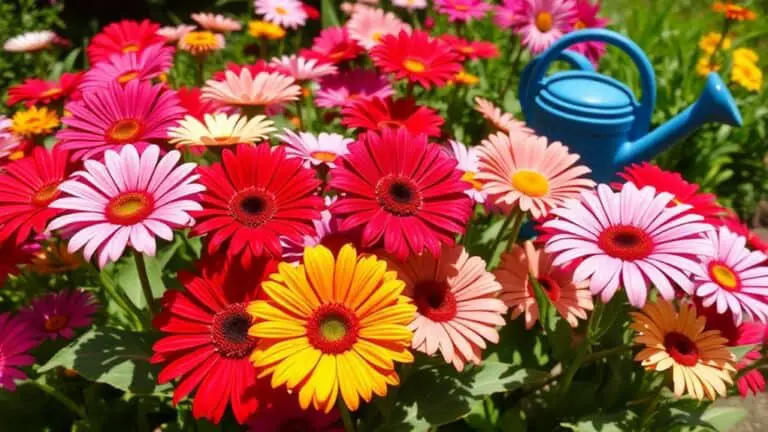Foods You Can Grow In Buckets All Year
I’ve found that growing food in buckets all year is a practical way to guarantee a steady supply of fresh produce, no matter the season. With the right techniques, you can cultivate a variety of plants like leafy greens, root vegetables, and even fruiting varieties. The key lies in selecting the right soil, maintaining proper light and moisture levels, and using organic fertilizers to boost growth. Imagine having fresh kale, tomatoes, and herbs right at your fingertips. Curious about the specifics? There’s a lot more to uncover on this topic that could transform how you approach home gardening.
Leafy Greens
Growing leafy greens in buckets is an excellent way to guarantee a fresh supply of nutritious vegetables year-round. Using 5-gallon buckets, you can grow indoors and enjoy leafy greens like arugula, kale, and spinach.
Arugula thrives in sunny, cool spots and can be harvested within 30-40 days, offering a continuous supply of spicy leaves. Kale matures in 55-65 days, and regular pruning helps it thrive even in warmer weather. Spinach grows quickly and is another fantastic option for container gardening, ready to harvest in no time.
These methods make it easy to manage and harvest your greens, ensuring you always have fresh, healthy options right at your fingertips, regardless of the season.
Root Vegetables
Root vegetables like carrots, beets, and potatoes are fantastic for growing in buckets at home.
To guarantee they thrive, make sure they get consistent moisture and the right amount of sunlight, usually around 4-6 hours a day.
You’ll enjoy harvesting fresh, homegrown veggies in no time, and they don’t take up much space!
Optimal Growth Conditions
When cultivating root vegetables like carrots and beets in buckets, you’ll need to secure they receive at least 4-6 hours of sunlight daily and are planted in deep, well-draining soil. To achieve ideal growth conditions, keep the soil consistently moist to support healthy root development. Carrots should be planted 0.5 inches deep in enriched soil, while beets can yield approximately 10 per 5-gallon bucket. Successional sowing extends the growing season, maximizing your harvests.
Here’s a quick guide:
| Root Vegetable | Planting Depth | Harvest Time (Days) |
|---|---|---|
| Carrots | 0.5 inches | 65-80 |
| Beets | 0.5-1 inch | 50-70 |
Consistent care secures vibrant and productive plants!
Harvesting and Maintenance
Harvesting root vegetables from buckets is a straightforward process that rewards your diligent care.
To guarantee your plants grow well, focus on maintenance like regular watering to keep the soil moist but not waterlogged.
For carrots, you’ll know it’s time to harvest after 65-80 days when their tops peek above the soil.
Beets mature in 50-70 days, and you can gently pull them up when they’re about the size of a golf ball.
Potatoes take a bit longer—10-20 weeks—but it’s worth the wait. Just tip the bucket and sift through the soil to collect them.
Keeping an eye on soil moisture and sunlight will guarantee healthy plants and a bountiful harvest.
Happy growing!
Fruiting Vegetables
Now, let’s talk about some fruiting vegetables you can grow in buckets!
Tomatoes, bell peppers, cucumbers, eggplants, and zucchini all thrive in containers with plenty of sunlight.
With the right care, you’ll be enjoying fresh harvests in no time—just make sure they get 6-8 hours of light daily and follow a few simple maintenance tips.
Light and Temperature Needs
Fruiting vegetables like bell peppers, cucumbers, and eggplants thrive when they get 6-8 hours of sunlight daily. Light and temperature needs are essential for these fruiting vegetables. For indoor gardens, make certain they receive full sunlight and maintain consistent warmth. Tomatoes, for instance, love temperatures around 70°F (21°C) during the day and slightly cooler at night.
| Vegetable | Sunlight Needs | Temperature Needs |
|---|---|---|
| Bell Peppers | 6-8 hours of sunlight | Warm, consistent |
| Cucumbers | 6-8 hours of sunlight | Warm, consistent |
| Eggplants | Full sunlight | Warm conditions |
Use nutrient-rich, well-draining soil with good drainage for healthy growth. Cherry tomatoes and compact eggplant varieties like Little Prince adapt well to containers, benefiting from adequate light. Happy gardening!
Container Gardening Tips
Growing fruiting vegetables in containers is a rewarding venture that offers fresh produce right at your doorstep. When using a bucket for container gardening, choose 5-gallon ones for plants like bell peppers and tomatoes. They need 6-8 hours of sunlight daily.
Bush varieties of cucumbers and zucchini also do well in these containers, needing similar sunlight.
Eggplants, especially compact types like Little Prince, thrive with 6+ hours of full sunlight and well-draining soil.
Make sure to water your vegetables regularly, keeping the soil consistently moist but not waterlogged.
Companion planting can help too; try growing basil with your peppers to enhance growth and deter pests.
With these tips, you’re well on your way to a fruitful container garden.
Harvesting and Maintenance
Keeping your container garden thriving involves a bit of diligence, especially when it comes to harvesting and maintaining your fruiting vegetables. Consistent watering is key; keep the soil moist but not soggy to prevent diseases. Nutrient-rich soil helps, but fertilization every 4-6 weeks guarantees your vegetables get what they need, especially during flowering and fruiting. Regular harvesting of cucumbers, tomatoes, and eggplants encourages continuous production. Don’t forget proper support structures like stakes or cages for vining plants; they help with healthy development and fruiting. Remember, 6-8 hours of sunlight daily is essential. Here’s a quick reference table to guide you:
| Task | Frequency | Tips |
|---|---|---|
| Watering | Daily | Keep soil moist, not soggy |
| Fertilization | Every 4-6 weeks | Use balanced fertilizer |
| Harvesting | When ripe | Promotes continuous growth |
Happy gardening!
Berries
When it comes to growing berries in buckets, it’s surprisingly straightforward and rewarding.
Blueberries thrive in 5-gallon buckets filled with acidic, well-drained soil. They need at least six hours of sunlight daily for ideal fruit production.
Dwarf raspberry varieties, like Raspberry Shortcake, also do well in buckets. Just remember to give them sturdy stakes for support and regular fertilization every two weeks.
Strawberries are fantastic for container gardening, providing fruit throughout the summer. They prefer slightly acidic, well-drained soil and benefit from mulching with compost to retain moisture and boost soil fertility.
Squash
As the weather warms up, squash becomes an excellent choice for bucket gardening. Using a five-gallon bucket, you can grow both summer and winter squash varieties. I recommend bush varieties since they’re compact and perfect for containers.
Make sure your soil is well-draining and rich in organic matter. Squash needs at least six hours of direct sunlight each day to thrive, whether you’re growing indoors or outdoors.
Water regularly to keep the soil moist, but not soggy. Depending on the type, harvest time ranges from 50 to 100 days.
For summer squash, pick regularly to encourage more growth. Winter squash, on the other hand, should be harvested when the skin hardens and the stem dries out, signaling it’s ready.
Happy gardening!
Bucket Selection
When choosing buckets for growing food, it’s essential to use food-grade plastic to keep your plants safe from chemicals.
Make sure your buckets are at least five gallons and have drainage holes to prevent waterlogging and root rot.
Reusing bakery icing buckets can be a great cost-saving option, but always check they’re food-safe and clean.
Food-Grade Plastic Safety
Selecting the right buckets for growing food is essential to confirm the safety and health of your plants. Always choose food-grade plastic to avoid harmful chemicals leaching into the soil. Look for buckets labeled with recycling symbols #1 (PETE) or #2 (HDPE), as these are safe for growing food. Avoid using any buckets that previously held toxic substances. Ascertain your buckets are at least 5 gallons to accommodate root systems and support healthy growth. Don’t forget the drainage holes; they prevent waterlogging and keep roots healthy.
Here’s a quick guide:
| Bucket Type | Label Symbol | Safety Note |
|---|---|---|
| Food-Grade | #1 (PETE) | Safe for growing food |
| Food-Grade | #2 (HDPE) | Safe for growing food |
| Non-Food | #3 (PVC) | Avoid, may leach chemicals |
| Non-Food | #6 (PS) | Avoid, may leach chemicals |
| Non-Food | #7 (Other) | Avoid, may leach chemicals |
Drainage Hole Importance
Proper drainage holes in your buckets are vital for maintaining the health of your plants. Without them, waterlogging can occur, leading to root rot and other issues. Here’s why you need them:
- Prevent Waterlogging: Guarantee at least 4-6 holes for excess water to escape, keeping soil moisture levels ideal.
- Promote Healthy Root Growth: Drainage holes allow oxygen to reach roots, which is important for nutrient absorption and plant growth.
- Use Food-Grade Buckets: These are safe for edible plants and often come with pre-drilled holes or can be easily modified.
Regularly check and clear any clogged holes to maintain proper drainage, making sure your plants thrive year-round.
Soil and Nutrients
In bucket gardening, achieving the right soil and nutrient balance is key to cultivating healthy plants. I always start with a high-quality potting mix to guarantee good drainage and aeration.
Adding compost enriches the soil with essential nutrients and improves its structure. Regularly checking pH levels is vital; aim for a range of 6.0 to 7.0 to keep your veggies and herbs happy.
Don’t forget to apply balanced fertilizer every few weeks, adjusting based on your plant’s needs.
Mulching with straw or shredded leaves helps retain moisture and enriches the soil as it breaks down.
Light Requirements
After confirming your bucket garden’s soil and nutrients are maximized, it’s time to focus on light requirements. Light is essential for your indoor garden’s success.
Here are some guidelines to guarantee your plants get the light they need:
- South-facing windows: Ideal for providing 6-8 hours of natural sunlight, perfect for most fruits and vegetables.
- Grow lights: Vital for fruiting vegetables like tomatoes and peppers, which need 12-16 hours of light for ideal growth.
- Reflective surfaces: Surrounding your buckets with reflective materials can enhance light distribution, assuring even growth.
Leafy greens like spinach and lettuce are more adaptable, needing only 3-4 hours of sunlight.
Regularly rotating your buckets will help maintain even light exposure and prevent uneven growth in your indoor garden.
Watering Techniques
Maintaining the right moisture levels in your bucket garden is vital for healthy plant growth. In a container garden, it’s important to keep the soil moist but not soggy to avoid root rot.
I always check the soil moisture regularly, especially in warmer conditions, as containers dry out faster than ground soil. Consistent moisture is key, and using self-watering pots or drip irrigation systems can help manage this efficiently.
I also make certain to water early in the day to minimize evaporation and allow plants to absorb moisture before the heat kicks in. Harvesting rainwater is another great way to water sustainably.
Fertilization Practices
Although maintaining the right moisture levels is essential, regular fertilization is equally important for bucket gardening success.
I always aim to enrich my plants with nutrient-rich soil through consistent fertilization. Here’s a simple plan:
- Organic Fertilizers: Use compost or worm castings to provide essential nutrients.
- Liquid Fertilizers: Apply them every two weeks for fast absorption.
- Slow-Release Fertilizers: Mix these into the soil at planting time for long-term feeding.
I also keep an eye on plant health by monitoring leaf color and growth rate, making adjustments as needed.
Conducting soil tests helps me understand nutrient levels and pH, ensuring I select the right fertilizers.
With these practices, my bucket garden thrives all year!
Frequently Asked Questions
What Food Can You Grow in Buckets?
I’ve found bucket gardening perfect for space-saving methods in urban farming. You can grow container vegetables like leafy greens, root veggies, fruiting plants, herbs, and strawberries. Just guarantee proper soil requirements, plant care, and seasonal rotation.
What Edible Plants Can You Grow Year-Round?
When it comes to edible plants you can grow year-round, herb varieties like basil and parsley are great for container gardening. Indoor gardening allows for effective nutrient management, pest control, and space optimization, ensuring successful seasonal planting.
What Is the Easiest Fruit to Grow in Buckets?
The easiest fruit to grow in buckets is strawberries. Strawberry varieties thrive in well-draining soil and plenty of sunlight. Blueberry bushes, container raspberries, dwarf apple trees, fig trees, citrus fruits, and grape vines are other great options.
What Foods Can Be Grown Year Round?
I’ve found that with indoor gardening and bucket gardening, you can grow foods year-round by managing soil types, seasonal planting, and pest management. Using hydroponic systems and crop rotation, I keep my tomatoes, peppers, kale, herbs, and microgreens thriving.
Conclusion
Growing food in buckets year-round is a fantastic way to enjoy fresh, homegrown produce no matter the season. You’ll find that with the right mix of leafy greens, root veggies, and fruiting plants, your gardening efforts will be super rewarding. Just remember to use high-quality soil, keep an eye on sunlight, water regularly, and fertilize as needed. Trust me, you’ll love the convenience and satisfaction of picking your own food right from your bucket garden!






